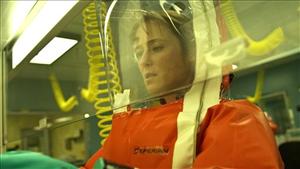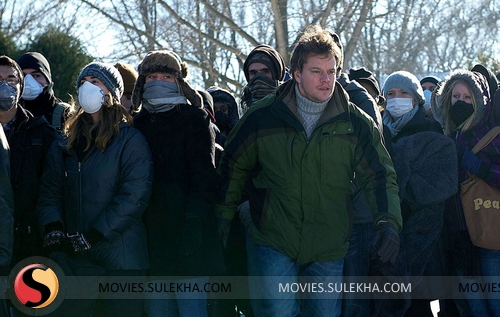Entries in pandemic (25)
Cases continue to mount in H7N9 outbreak
 The H7N9 outbreak continues to grow. This morning, both Flutrackers and Avian Flu Diary are reporting multiple Chinese stories that two new and previously unreported human H7N9 cases have been found in Hangzhou, Zhejiang Province. Both cases have died.
The H7N9 outbreak continues to grow. This morning, both Flutrackers and Avian Flu Diary are reporting multiple Chinese stories that two new and previously unreported human H7N9 cases have been found in Hangzhou, Zhejiang Province. Both cases have died.
The machine translation from Chinese to English can be problematic where date (well, pretty much anything else) is concerned, so it takes skill to parse correct dates from the rest of the dialogue. Regrettably, that is a skill I lack. But many others do, and these talented people are all located on Flutrackers.com.
There appear to be two separate dates of infection. One apparently is the 7th of March, and the other is the 25th of March. But what is plain is that this brings a fourth province -- and third coastal province -- into the picture. By any yardstick, we have not yet defined the scope of this outbreak. Although it appears human-to-human transmission may or may not yet be possible, and as we covered at length yesterday, H7 can and does infect humans, the cat appears to be out of the bag.
The biggest impediment to getting our arms around the scope of the crisis (yes, I consider this to be a crisis, because we have a novel strain of influenza that no one, outside a random poultry worker or hunter is immune to, and it is killing people): It is not killing poultry. Sentinel chickens (the proverbial canary in a coal mine), used to help detect the presence of avian influenza, may be asymptomatic carriers of the disease. At least that is one oprevailing theory, which would also explain why and how this virus escaped surveillance and, thus, early detection.
You always knew when H5N1 bird flu was close by: You could follow the trail of dead and soon-to-be-dead chickens. H7N9 is not killing chickens. Nor, contrary to what our deepest nightmares and feelings might tell us, is it killing pigs.
My blog of yesterday mentioned a Dr. Yin of the Bill and Melinda Gates Foundation. Apparently Dr. Yin is the Foundation's leader in China. And it was quite satisfying, knowing Bill and Melinda are spending funds in China, including, but not limited to, surveillance. Dr. Yin's statement is worth paraphrasing. He said, basically, if you don't test for H7N9, you won't find it. But if you do test for it, you'll find it. The inference is that there have been numerous unexplained and undiagnosed severe respiratory ailments there this season. Retroactive testing of samples, based on Dr. Yin's inference, will yield a significant increase in the number of H7N9 human cases.
I am hopeful that the CDC here will start looking at the number of "A (subtyping not performed)" samples still lingering around.
All eyes on China as novel influenza virus emerges
The world woke up Easter Sunday to some pretty unsettling news. No, it was not about that twit in North Korea. The news came out of China, and it hit hard enough for me to start blogging again.
China is the source of a novel H7N9 influenza virus. And the virus is infecting, and killing, humans.
In the past three years, I have written a small handful of infectious disease blogs. I just felt that I had nothing to contribute; people such as my buddies Mike Coston, Crof and Maryn McKenna were filling that space quite nicely, and I could not offer anything of value.
Then, a few months ago, I began to formulate a concept in my mind. Things were just too dang quiet, I thought. H1N1 was still infecting and killing overseas, but H3N2 was the principal culprit in North America. Odd, I thought: Flu always plays King of the Mountain. Why should a seasonal strain be more prevalent -- and also more deadly -- than the recent pandemic strain?
I looked at this novel coronavirus situation in the Middle East. What the heck was going on with that? As I began the research into this novel coronavirus, I thought what everyone else was thinking: Is this the Next Big Pandemic?
And, as always, Mother Nature shows us who is boss. She shows us that you simply cannot predict when something is going to pop up and take all us arrogant humans by the scruff of the neck and shake us and berate us for ever, ever thinking we know what is coming.
Here, in a capsule of a capsule, is what we know, as of 1PM EDT on the second of April, 2013.
Sometime in mid-February, a family of three Chinese men in Shanghai -- an 87-year-old father, and two sons, aged 55 and 69 -- contracted something very, very virulent. Two of the men died. The lone survivor was hospitalized with pneumonia (alarm bell #1). The dead father was discovered to have had H7N9 influenza. H7N9 was not found in the two sons. The younger son also died. H7N9 was not found in him. The inescapable fact is that all three men suffered from terrible pneumonia, and two died. As we all know, pneumonia is the most prevalent byproduct of influenza. No one is going on the record as stating, flatly, that the other two cases were not H7N9. They are saying they did not detect any. There is a difference.
In early March, about two hundred miles away, a 35-year-old woman contracted something very, very virulent. She, too, was diagnosed with H7N9 influenza (alarm bell #2).
It took the Chinese authorites until March 31st -- March 31st -- to disclose that, indeed, there was the presence of a novel influenza, never before seen in humans. I suppose we should celebrate the fact the Chinese disclosed anything at all. And the Chinese are, apparently, doing their due diligence. Some 88 contacts of the three men have been monitored, and to date, none have shown symptoms of respiratory distress. That would seem to downplay the possibility of human-to-human transmission.
This would be all fine, well and good, except for one small fact: We are getting reports of more cases. Just as I was fact-checking this blog, news arrived of four more cases, again disclosed by the Chinese government. All the new cases come from a third province. Quoting from the proMED dispatch:
The number of confirmed human cases of avian A(H7N9) influenza virus infection has now risen to 7; the number of fatalities remains at 2.
The condition of the 4 new cases is critical, and all remain in hospital. None of the 4 new cases are related to the previous 3 cases or to each other. Only one of the new cases has had daily contact with birds, a 45-year-old woman who is described as a poultry butcher. The pattern remains the same, presumptive direct infection from poultry and no evidence of person-to-person transmission. The overall situation is becoming more serious, suggesting that many people may be directly susceptible to a strain of avian A(H7N9) influenza virus that may be widespread in the avian population (wild or farmed) in China.
The consequences of infection by this virus appear to be severe. - Mod.CP
The number of human cases of infection via H7 influenzas is considerable. Mike Coston has constructed a nifty history of those infections in his recent blog post, so I will not attempt to replicate his fine post. Suffice it to say that H7 is known to scientists and researchers, but (up to now) its ability to cause serious illness in humans, save for one hapless vet in the Netherlands a few years ago, is small.
Until now.
Crawford Killian, the noted author and flu blogger, has an excellent post today. The spource is an AP story on the outbreak. It quotes a researcher from the Bill and Melinda Gates Foundation.
"When you don't look, you don't find them, but when you look, you'll find," said Dr. Ray Yip, a public health expert who heads the Bill and Melinda Gates Foundation in China.
"A lot of people get severe respiratory conditions, pneumonias, so you usually don't test them. Now all of a sudden you get this new reported strain of flu and so people are going to submit more samples to test, [so] you're more likely to see more cases," Yip said.
All eyes on Hebei Province, China as mystery illness provokes government action
Sharon Sanders and the posters at Flutrackers are reporting some pretty weird events in Hebai Province, China. First, let's locate Hebei on the map.
 A series of seemingly disassociated events, when viewed at a higher level (as Sharon has done in her Flutracker posts), paints a picture of Hebei as in some sort of state of emergency (my words). Shops closed by force. People required to wear masks. A thousand police officers dispatched to maintain discipline. And, in the most stark post yet, occupancy at the regional hospital exceeding 100% and an isolation ward erected.
A series of seemingly disassociated events, when viewed at a higher level (as Sharon has done in her Flutracker posts), paints a picture of Hebei as in some sort of state of emergency (my words). Shops closed by force. People required to wear masks. A thousand police officers dispatched to maintain discipline. And, in the most stark post yet, occupancy at the regional hospital exceeding 100% and an isolation ward erected.
Official (meaning government) reports coming from the region speak of the virus actually being Adenovirus 55, and not the dreaded (and rumored) SARS virus. We know the Case Fatality Rate from SARS hovered, eventually, around 10% of the sick. A hospital filled with a thousand sick would produce at least a hundred dead, if the virus were SARS. Rumors and slim media accounts seem to converge on just one person dead so far.
What we know of Adenovirus 55 is limited, but growing. A paper that was published in 2009speaks of the first (and until now, last) major outbreak of Ad55. Ad55 will produce some serious respiratory distress, but blessedly, only one death in 254 infected Chinese students in Shaanxi Province, China. Here's the map showing the location of Shaanxi:

As you see, Shaanxi is two provinces over from Hebei. I do not think it would be much of a stretch to say that this entire region may want to re-evaluate all its respiratory distress cases and outbreaks since 2005 to see if Ad55, instead of flu, could be an explanation.
Of course, what fascinates me is that China was able to come up with a positive diagnosis of Ad55 so quickly. Long-time readers of this Blog (if I still have any!) know that I have been campaigning for testing for Ad14, which has a long and ugly reputation in military bases all over America, and hospitals in the Pacific Northwest. As the medical report from 2009 attests, a "tsunami" (their words) of genetic information relative to Adenovirus is pouring in to researchers. Good! Maybe we will begin to take Adenovirus more seriously.
In the meantime, it is also interesting to see what lengths the Chinese government will go to try to isolate anything that even remotely resembles SARS. The government's zeal to prevent or mitigate the spread of an infectious disease is "disconcertingly refreshing." Feel free to use that phrase. It is troubling, no doubt, to see government trucks rolling into a province, and that has to evoke bad memories for the residents. From a global perspective, however, and especially in light of the aftereffects of the film "Contagion," any attempt to contain a pathogen and prevent it from spreading is appreciated, as long as the actions are 1) justified, 2) non-lethal, and 3) abandoned, once the pathogen is proved to be relatively harmless.
“Contagion” is a Deeply Unsettling, Haunting – and (Mostly) Realistic – Pandemic Film
 Those of us who have made pandemic preparedness part of our curriculum vitae could not have been more excited about the premiere of Steven Soderbergh’s latest film, ““Contagion”.”
Those of us who have made pandemic preparedness part of our curriculum vitae could not have been more excited about the premiere of Steven Soderbergh’s latest film, ““Contagion”.”
And we were not disappointed. “Contagion” is a paragon of what an intelligent biological thriller should be: hyper-accurate, absorbing, and, most of all, a film that reminds us of our own individual responsibilities within a civilized society.
Not to say that there’s not a little bit of Hollywood in this film. More on that later. First, let’s take a look at how the movie was made, the etiology of the fictional virus, and what Hollywood got right. And in many cases, they got it absolutely right.
What “Contagion” got right
The MEV-1 virus in the movie is the brainchild of Dr. Ian Lipkin, of Columbia University. Dr. Lipkin directs the Center for Infection and Immunity at the Mailman School of Public Health at Columbia. He was contacted by Soderbergh and the film’s writer, Scott Z. Burns. He agreed to come on board the production as a paid technical and science adviser.
Dr. Lipkin created a virus for the film that is patterned after an actual virus: The Nipah virus. Nipah was first discovered in Malaysia in 1999. The natural reservoir of Nipah is in the Malaysian fruit bat population. The WHO reports that Nipah has also been found in bat urine and in partially-eaten fruit in the region. Oh, by the way: The real-life bats in question are migratory. Toward that end, antibodies to a virus very similar to Nipah have been found in India, Indonesia and Timor.
There is a danger in making bats the heavy in the film. Bats are essential in such areas as insect control. And North American bats are dying by the millions, due to “white-nose syndrome,” a fungal infection that essentially suffocates bats during their annual hibernation.
But bats are also vectors of some of the world’s most dangerous diseases, especially Ebola – and SARS.
While the MEV-1 virus is patterned after Nipah, the pattern of infection is modeled after the SARS virus. How quickly we forget how threatening SARS really was. In bookstore remainder bins all over the continent, one can find Karl Greenfield’s seminal work on the SARS epidemic, titled, “ China Syndrome: The True Story of the 21st Century's First Great Epidemic.” I highly recommend his book.
 While the original vector of SARS in 2002/03 was a “civet cat,” a peculiar-looking mammal, it may be that the civet cat in question was infected by a bat. SARS virus has been found in Brazilian bats, so the danger is not localized to Southeast Asia by any means.
While the original vector of SARS in 2002/03 was a “civet cat,” a peculiar-looking mammal, it may be that the civet cat in question was infected by a bat. SARS virus has been found in Brazilian bats, so the danger is not localized to Southeast Asia by any means.
Had SARS been more like influenza and less like the common cold, we would have seen a pandemic that would have made 1918’s Spanish Flu look like the common cold. In the US, the H1N1 Spanish Flu pandemic killed 2.5% of everyone it infected. In contrast, SARS killed 10% of those it infected, worldwide. But luckily for us (“us” being the world), SARS infected so quickly, public health professionals got in front of the disease and eventually beat it down. It is counterintuitive to be sure, but a disease that infects quickly is easier to corral than one with a days-long incubation period, such as influenza.
To go into how SARS infected and killed would also produce those obligatory “SPOILER ALERT!!” warnings and disclosures, which I want to avoid (where possible) in this review. So suffice it to say that “Contagion” is disturbingly accurate when it comes to how quickly it was able to infect on a global scale.
SARS was not the exclusive province of China, Toronto or Singapore. Two prominent Tallahassee residents (who I obviously cannot identify for HIPAA reasons) were infected by SARS during a visit to China in 2003. The CDC and WHO were actually monitoring their health following their return to Tallahassee. By proxy, they were monitoring Tallahassee for signs of SARS infection.
So what Soberbergh, Burns and Lipkin created were a perfect fit of an established disease and historic established routes of transmission. In other words, extremely realistic.
Dr. Lipkin also taught the cast how to correctly don protective gear, and how to speak the language of disease.
In the movie, the Elliott Gould character, Dr. Ian Sussman (yes, a probable nod to Dr. Ian Lipkin) is able to finally grow a sample of MEV-1 to produce a vaccine candidate. This storyline parallels the first attempts to grow H5N1 in chicken eggs to produce a vaccine. Bird flu was killing the eggs. That was eventually overcome. Of course, H5N1 poultry vaccines have arguably done more harm than good, but that is a matter left to my previous blogs on the subject.
Elliott Gould’s Dr. Sussman is handling the virus in a Level 3 lab, and the CDC has already ordered all samples not contained in a Level 4 lab to be destroyed by fire. Dr. Sussman’s on-screen disregard for CDC protocols is reminiscent of the spanking that real-life Dr. Yoshihiro Kawaoka of the University of Wisconsin received in 2007 for handling “copies” of the dreaded Ebola virus in a level-2 lab.
Laurence Fishburne’s admonition that “We don’t want that virus leaving on the bottom of someone’s shoe” refers to a frequent and ongoing concern. For more information, refer to my ongoing blog series, “When labs attack.”
What “Contagion” could have done better
Where the movie deviates from probability, in this reviewer’s opinion, is in its depiction of how society would react to the virus. These deviations are all permitted, because they are clearly possible. It is just in the areas that were left out that very minor – and forgivable – faults can be found.
In less than a month, society pretty much goes over the cliff. Garbage lies uncollected and strewn about neighborhoods. Unions strike, rather than perform their duties. Governors call out the National Guard and seal borders without apparently seeking consultation from Washington. And while grocery stores are ransacked and food is extremely scarce, the lights and phones somehow stay on.
The Enemy of the People in any pandemic is the stability of the supply chain. That just-in-time supply chain is the most fragile part of our economy. The level of global apprehension, not to mention the Case Fatality Rate of the MEV-1 virus in the film, would have produced much more damage to the global supply chain.
Those of us who are sought-out as experts in pandemic preparedness often point to unions as a cause for concern. In fact, pandemic planners factor in possible union (in)actions in their calculations, but I believe that people are also capable of doing heroic things. The public health experts in “Contagion” are justifiably viewed as heroic. But as we saw on 9/11, and as we were reminded this past weekend, heroism is not limited to one exclusive group of people.
However, the images of public employees such as law enforcement officers abandoning their posts in New Orleans during Katrina – and even joining in the looting and pillaging, in a few cases – is also testament to our individual faults and failings. That, too, can be seen in “Contagion,” even at the higher levels of the government.
The film did not damage the critical infrastructure enough. In a prolonged, 1918-type pandemic, we believe ports will clog, phones will become unreliable, and power will come on and off – all because there will not be sufficient levels of people healthy enough to work to maintain them, nor will there be sufficient numbers of people to work, due to absenteeism to take care of loved ones. And there are always those who will burn sick days just for a headache. We have estimated that, at the height of a pandemic, as much as a third of the workforce might be absent on any given workday.
 The movie attempts to display the deterioration of society in a few select scenes, but the film did not go far enough in its depiction of the degradation of the infrastructure. It did show the requisite looting of grocery stores, and certain unsettling acts of violence, and it did an excellent job in its frequent shots of uncollected refuse.
The movie attempts to display the deterioration of society in a few select scenes, but the film did not go far enough in its depiction of the degradation of the infrastructure. It did show the requisite looting of grocery stores, and certain unsettling acts of violence, and it did an excellent job in its frequent shots of uncollected refuse.
In a real-life, lethal pandemic, the military would be called upon to perform these tasks. That would include the National Guard, which I must believe would be Federalized early on, in order to prevent the types of actions that were undertaken by individual governors as the pandemic worsened. Federalizing the Guard places those units under the direct control of the Pentagon. Governors lose their Guard in that scenario. I would have to believe that the president would exercise that authority very, very early on in this process.
Sealing the borders, for example, has been almost completely tossed as a realistic countermeasure. The SARS epidemic and the H1N1v “swine flu” pandemic showed how border closures would be ineffective to restrain any virus.
This point (along with the supply chain issue) was actually done very well in the TV-movie “Fatal Contact: Bird Flu in America”. In that film, the military is called home from Iraq and Afghanistan to help maintain law and order. I would expect governors to call all their Guard units home, to assist in stabilizing the infrastructure of their states and to curtail inevitable violence.
Other than the depiction of labor unions as petty and self-serving, “Contagion” also serves as a confirmation of the Second Amendment during a crisis. Cops are not around when the shooting starts. Self-defense is the order of the day. Being armed equals being safe. These are two curious messages to be dealt by a Hollywood director, and I found it to be refreshing.
SPOILER ALERTS COMING!
My family felt that it was a little preposterous that key public health people would not continuously wear their masks and gloves, especially in public. We have had many discussions regarding the efficacy of wearing masks in public, however, and I defer to the writer and director on this topic.
Another concern (the most deeply-rooted one) is in the film’s conflict between the CDC and the Minneapolis public health unit. This is where the Hollywood formula kicks in, resembling a Criminal Minds episode where the local cops resent the FBI intrusion into their bidness. The reality is that local public health units generally work very well with the CDC, and welcome their participation when things go bad. In my experience, the CDC is a first-rate organization, led by top-flight people. Local public health units do the best they can do, especially in this current economy, but “overwhelmed” would be an understatement on any given workday – let alone during a pandemic.
Dr. Michael Osterholm, head of the Center for Infectious Disease Research and Policy at the University of Minnesota (and who worked at the Minnesota Department of Health for a quarter-century), alluded to this during a recent “Contagion”-inspired interview. In fact, the Minnesota Department of Health is one of the best-run departments of its kind in the country.
The other area that the movie (which runs a brisk 106 minutes) glosses over is within the subject of vaccine production. Public health experts such as Dr. Osterholm have stated that the movie’s scenario for vaccine production is too rosy (my words). Vaccine production takes months, even in a “good” viral situation such as producing an influenza vaccine. It took every bit of six months just to produce the swine flu vaccine.
With a new and previously-unseen virus, especially considering the repeated failures of the prototypes, it would take considerably longer. The wait for vaccine could take almost a year, causing further destruction of the global economy and the further erosion of the critical infrastructure. And this does not even deal with the issue of who gets vaccine and who does not.
In another “Contagion”-imitates-life example, a Chinese group has kidnapped a WHO official, and demands -- as ransom -- vaccine produced in the West. This is a nod to the possibility of natively-produced substandard or even counterfeit vaccine. It is nice to hear someone demanding America vaccine –anything – because it is the best in the world. Note, at the end of the movie, the architecture of the open-air school housing the Chinese children.
The vaccine issue is personalized within the village, but once again, the script alludes to larger global issues. In this case, the rural, poor demand for vaccine speaks to the problems caused by Indonesia in the fight against bird flu. Back in 2007, the Indonesian government refused to share human bird flu samples – or even to quickly report human bird flu cases and deaths – simply because they felt their samples would make the global pharmaceutical companies billions of dollars, and, at the end of the day, leave Indonesia without any vaccine. It took years for the West to negotiate an agreement with Indonesia to give them vaccine in exchange for human bird flu samples.
The movie did do a good job of showing the agony involved with waiting and waiting until their vaccine lottery number was called. I found the prospect of a “vaccine lottery” to be a curious and interesting (and fair) way to resolve the issue of who got vaccine and when. The reality is, there is a schedule of who gets vaccine, at least within the first responder community, the military and the government. The Strategic National Stockpile has the goods. The Department of Homeland Security and state governments have the plans. After that, I doubt if there is a plan, so the lottery idea seems as fair as any.
Finally, we need to address the issue of the blogger character played by Jude Law. “Blogging is graffiti with punctuation,” Elliott Gould admonishes Law’s character. Law’s Alan Krumwiede is the worst sort of blogger, one who is only interested in promoting his “brand” at the expense of the truth, not to mention people’s very lives, by promoting an unproven homeopathic “remedy.” He is the 21st Century snake oil salesman, shamelessly hawking an elixir that is eventually proven to be dangerously ineffective.
Fortunately, I do not know any bloggers personally who would fit into those shoes. My disease-blogger friends are all dedicated people who, in their minds and in mine, are performing a valuable service by alerting their readers to some very real threats and dangers. Their surveillance uncovered the swine flu pandemic before the world’s press did, and their work on tracking H5N1 has proven to be extremely accurate. I hope Law’s Krumwiede would not get the attention he gets in the movie. However, having sat numerous times where Law’s character sat, in a quiet studio, in front of a television camera with an IFB in my ear, talking to a reporter or a network news anchor, I can understand how a marginal “playa” could become a fiend, mainstreamed by the press. It is up to the individual to censor him/herself and to produce accurate content.
Summation
““Contagion”” is an incredibly well-researched, disturbingly plausible, and extremely well-made film. With the exceptions of the vaccine production timetable and the downplaying of the damage to the economy and the critical infrastructure, Soderbergh and Burns got it right. Soderbergh is his own cinematographer as well (under a nom de plume), and his use of “available light” in place of standard movie lighting techniques makes the film feel much more realistic -- which means, of course, much more disturbing. The cast, without exception, is fantastic. Gwyneth Paltrow factors heavily throughout the film, so her apparent quick departure in the film’s first act is compensated for throughout the movie.
And equally exceptional is the villain, the MEV-1 virus. The fact that it is based on a real virus should wake us all up to the need to engage more strenuously in personal hygiene, and remember the things Momma taught us:
- Wash your hands frequently.
- Cover your cough, not with your hands, but with your sleeve, or a handkerchief or napkin.
- Keep a respectable distance from strangers.
Now go put on your Level 4 gear and go see the movie!
Here are some other sites, in case you want more “Contagion” stuff:
Mike Coston’s superb Avian Flu Diary, and his entry on the movie.
http://afludiary.blogspot.com/2011/09/why-you-should-catch-”Contagion”.html
An interview with Dr. Mike Osterholm on the accuracy of “Contagion”:
http://www.startribune.com/lifestyle/wellness/129464038.html
And a dynamite Wired blog, written by the extremely talented Maryn McKenna, featuring an interview with Dr. Ian Lipkin. Maryn has two books in print that hypochrondriacs should not read. Her latest is on MRSA and it is called Superbug. Find it at your local bookstore, if one still exists, or order it from Amazon.
http://www.wired.com/wiredscience/2011/09/”Contagion”-questions-spoilers/all/1
Last, and least, an article on “Contagion” from a Palm Springs, California newspaper, with some quotes from yours truly.
http://www.mydesert.com/article/20110911/NEWS01/109110341/-”Contagion”-not-far-fetched
"We just need to make sure that nobody knows, until everybody knows" -- enjoy these clips from "Contagion"
The entertainment Website Filmonair.com has put up some clips from the Steven Soderbergh disease thriller "Contagion." enjoy them and listen to A-list actors deliver such lines as "social distancing" and "Congress is figuring out how to work online."
